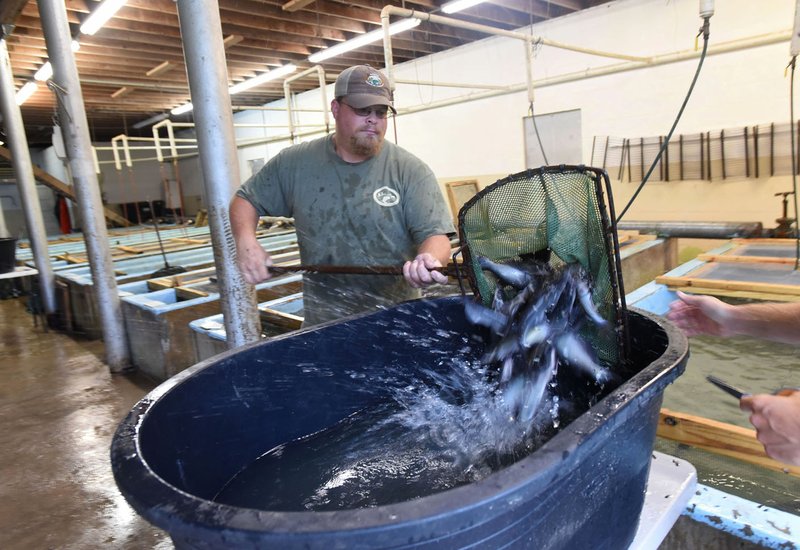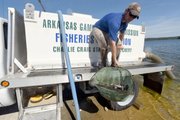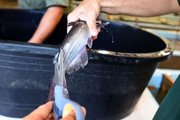The glow of a camping lantern shines on a fishing pole quivering like mad in a rod holder stuck in the mud of a Beaver Lake shoreline.
The angler leaps from a lawn chair under the stars, grabs the rod and cranks away with fingers that smell like stink bait. Just what the doctor ordered for catching catfish on their nighttime feed.
The big channel 'cat goes on a chain stringer. But is it a stocked catfish or one that was spawned naturally? The answer is in the fin on the back of the channel 'cat, thanks to a study by the Arkansas Game and Fish Commission.
Game and Fish staff in August clipped a tiny piece of fin from the backs of 60,000 channel catfish raised at the Charlie Craig State Fish Hatchery in Centerton. The fish were trucked to Beaver Lake and stocked at the Arkansas 12 bridge, Monte Ne and U.S. 412 bridge.
Fisheries biologists will place hoop nets in May and June on the lake bottom that are designed to catch catfish. They'll run the nets and see how many of the catfish they catch have clipped fins. Catfish from natural reproduction will have fins intact.
"If we see a lot with clipped fins, that tells us that we need to stock more catfish," said Jon Stein, Game and Fish regional fisheries biologist. If most fish in the nets have fins intact, it means natural reproduction is good.
This is the first year of the study, Stein said. It's designed to let Game and Fish know if catfish need to be stocked from year to year. The channel catfish spawn is successful some years, poor in others.
Catfish spawn when the water temperature is 78 to 80 degrees, usually in June, Stein said.
Fin clipping requires a platoon of Game and Fish workers. Ten or so men wearing rubber boots or waders handled the wiggling catfish, which averaged 8 inches long. With nippers they clipped a small piece of spine from the adipose fin, located behind the dorsal fin.
Clipped catfish went into the tank of a stocking truck, then were transported to Beaver Lake and released. The crew sweated for three days clipping 60,000 catfish.
These channel catfish started as eggs at the Lonoke state hatchery. Fish were chauffeured to Centerton as fingerlings, said Joe Adams, hatchery manager at Centerton.
Biologists will place bait in the nets to lure catfish when netting time comes in the spring. Or, they could do laundry with the bait. Zote soap is placed in the nets to bring in the 'cats.
"It's a soap that's high in fatty acid that gives off a residue that attracts catfish. You can use it to wash clothes, too," Stein said.
A computer search revealed that Zote soap is sold much more for laundry and handwashing than attracting catfish.
No need to do a fin clip study on the region's smaller lakes, Stein explained. Biologists already know that catfish natural reproduction is poor on most of them. Catfish are cavity spawners and there aren't enough hollow logs, ledge cover or holes for good spawns.
"If we didn't stock them, the small lakes wouldn't have any catfish," Stein said. Channel catfish eat all kinds of bait. Nightcrawlers, liver, worms, hot dogs and stink bait all holler "come and get it."
The fin-clip study at Beaver is about channel 'cats. Biologists know the lake has a tremendous population of flathead catfish, Stein said. Past research and angler reports prove it.
"There's a lot of big ones. Fifty and 60 pound fish," he added. "They really catch a lot on the south end of the lake."
Got the nerve to tangle with Mr. Big Flathead 'Cat? Bait up with small sunfish on a rod and reel, the biologist advised, and hang on.
Flip Putthoff can be reached at [email protected] or on Twitter @NWAFlip
Sports on 10/24/2017




